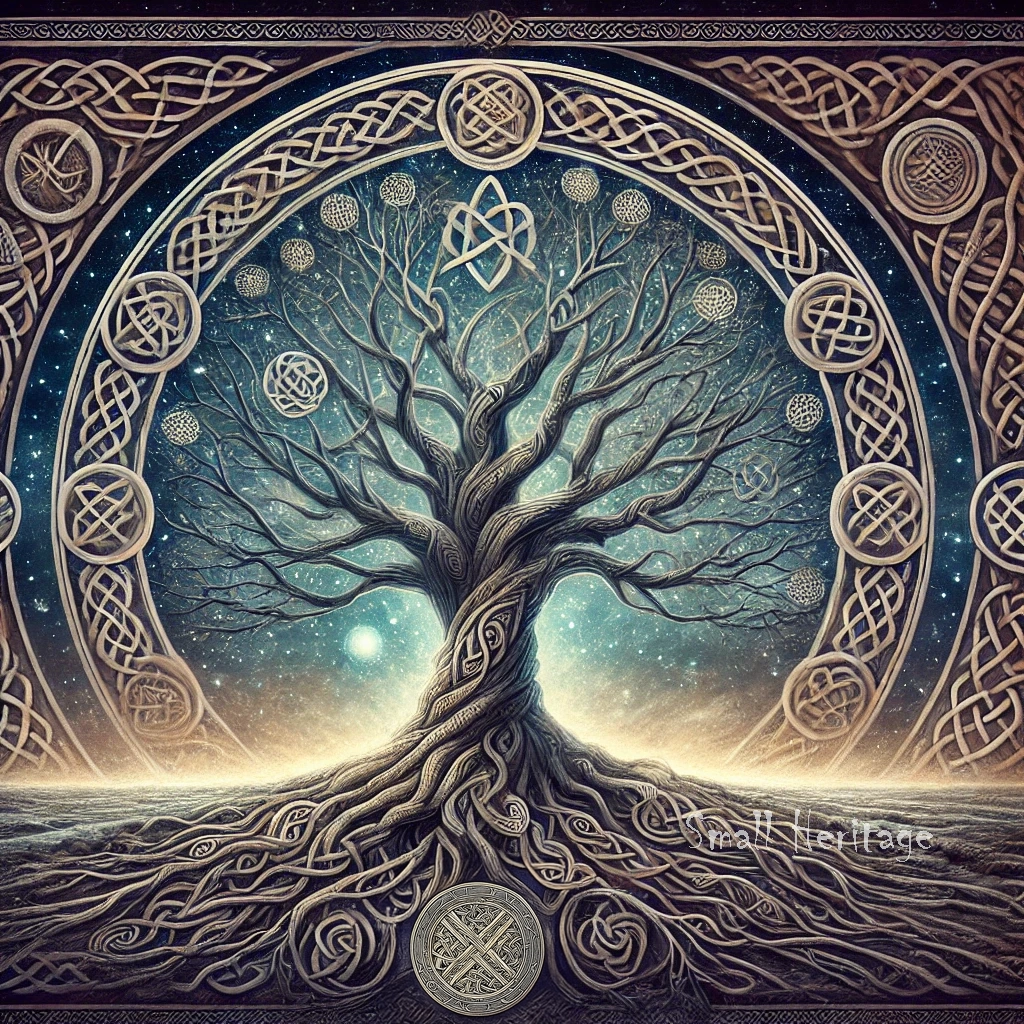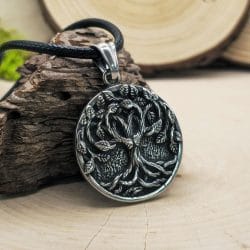
-
Shop by Type
-
Shop by Culture
-
Collections
Home » Blog » Cultural Heritage » The Celtic Tree of Life: Symbolism, History, and Modern Meaning

The Celtic Tree of Life is an ancient symbol that holds deep cultural and spiritual significance, primarily within Celtic tradition but also reaching into modern interpretations. Known for its intricate knotwork and intertwining branches and roots, the Celtic Tree of Life represents balance, harmony, and the interconnection of all life. Its symbolism touches on the cycle of life, death, and rebirth, while also acting as a bridge between the heavens, earth, and the underworld. In this post, we explore the rich history, symbolism, and modern adaptations of this timeless symbol.
The Celtic Tree of Life, or Crann Bethadh in Gaelic, has ancient roots in Celtic culture, where trees were seen as sacred, life-giving beings. In Celtic societies, trees provided shelter, food, and medicine and were revered as symbols of endurance and resilience. Among all the trees, the oak was particularly sacred and often represented strength, protection, and wisdom.
The Celtic Tree of Life embodies the ancient belief that trees serve as a link between the earth and the divine, connecting the material and spiritual worlds. The Celts saw trees as protectors and spiritual guides that contained wisdom beyond human understanding. Many Celtic tribes believed that certain trees were the dwelling places of gods and goddesses, making them central to religious ceremonies and rituals.
The Gaelic Tree of Life served as a central icon in Celtic culture. Tribes would often plant trees at the center of their settlements, and these trees became symbols of unity and peace. In addition to their practical uses, trees played a crucial role in marking territories and were involved in important cultural and spiritual events. The traditional Celtic Tree of Life symbolized the essence of these beliefs, blending the physical and metaphysical in one powerful icon.
The Celtic Tree of Life meaning is steeped in themes of balance, harmony, and interconnectedness. The roots of the tree extend deep into the earth, while its branches reach toward the sky, symbolizing the connection between the earthly and spiritual realms. The tree represents the balance between these realms, grounding us in the material world while allowing for spiritual growth.
One of the key aspects of the Celtic Tree of Life is its cyclical nature, which mirrors the cycle of life, death, and rebirth. Trees shed their leaves in the fall and bloom again in the spring, embodying the belief that death is not the end but a transition to another form of existence. For the Celts, this cycle represented the eternal nature of the soul and the ongoing connection between generations.
The Celtic knotwork tree is an essential element of the Celtic Tree of Life. The knots have no beginning or end, symbolizing eternity and the infinite cycle of life. The interwoven lines of the Celtic knot tree of life emphasize the interconnectedness of all living things and the importance of maintaining balance in nature and life.
The pagan Tree of Life also reflects similar beliefs, representing the unity of all existence and the connection between humans, nature, and the divine. In Wiccan and other pagan traditions, the Tree of Life continues to symbolize the interconnectedness of the universe and the continuous cycle of birth, death, and renewal.
The Tree of Life is not exclusive to Celtic tradition; it appears in various cultures around the world, each imbued with its own unique meanings and symbolism. Despite their differences, these representations share common themes of interconnectedness, renewal, and the eternal cycle of life.
In Norse mythology, the Tree of Life is known as Yggdrasil, an immense ash tree that connects the nine worlds. Yggdrasil is the center of the cosmos, with its roots extending deep into the underworld and its branches reaching high into the heavens. It is a symbol of the universe’s structure and the interconnectedness of all beings within it.



In Ancient Egypt, the Tree of Life represented fertility, abundance, and the cyclical nature of existence. The Egyptians believed that the tree connected the worlds of the living and the dead, symbolizing rebirth and eternal life. The Ankh, often seen in Egyptian artwork, is sometimes associated with the Tree of Life as a symbol of life and immortality.
Jewish mysticism also embraces the concept of the Tree of Life through Kabbalah. In Kabbalistic teachings, the Tree of Life is a diagram composed of ten interconnected nodes, representing the flow of divine energy from the heavens to the material world. Each node represents a different aspect of creation, and the entire tree symbolizes the path of spiritual enlightenment.
In Buddhism, the Bodhi Tree holds immense significance. Under this tree, Siddhartha Gautama, who later became known as Buddha, attained enlightenment. The Bodhi Tree symbolizes wisdom, enlightenment, and the journey toward spiritual awakening. Its presence in Buddhist art and practice serves as a reminder of the path to understanding and peace.
Mesoamerican cultures, such as the Mayans and Aztecs, also held the Tree of Life as a sacred symbol. In Mayan cosmology, the Ceiba tree represented the connection between the underworld, the earth, and the heavens. The tree’s roots were believed to extend into the realm of the dead, while its branches reached the divine sky, symbolizing life’s eternal cycle and the universe’s structure.
These various interpretations of the Tree of Life emphasize its universal appeal and its role as a powerful symbol of interconnectedness, wisdom, and the balance between life, death, and rebirth across different cultures.
In modern culture, the Celtic Tree of Life has transcended its original cultural boundaries and become a symbol of life, growth, and connection to nature. Its appeal stretches beyond Celtic traditions, finding resonance in various spiritual and cultural practices. Many people who appreciate nature, balance, and personal growth are drawn to the Celtic Tree of Life for its universal symbolism.
The Celtic Tree of Life meaning has evolved over time, but its core values of unity, interconnectedness, and eternal life remain central to its appeal. Whether through jewelry, art, or tattoos, the Celtic Tree of Life continues to inspire people to reflect on their connection to the natural world and their place within the larger universe.
The design’s timeless appeal also makes it a favorite in contemporary pagan and Wiccan traditions. The pagan Tree of Life shares many of the same themes as the Celtic version, emphasizing the relationship between humans, the earth, and the cosmos. For those who practice modern paganism, the Tree of Life represents the cycles of the natural world, the interconnectedness of all beings, and the spiritual journey through life and death.
The Celtic Tree of Life has evolved over the centuries, adapting to new artistic styles and cultural influences. The traditional depiction of the tree, with its intricate knotwork and balanced design, remains one of the most popular representations. However, modern artists have taken the Celtic Tree of Life in new directions, incorporating different elements such as animals, stars, or even abstract patterns.
In some designs, the Celtic Tree of Life is combined with other symbols, such as the Celtic knot or the pagan Tree of Life, creating new interpretations of this ancient symbol. The tree of life with Celtic knot is a popular design, especially in jewelry, as it represents the unity of the different elements of life and the endless cycle of existence.
The Celtic Tree of Life also appears in other forms of Celtic knotwork, where the tree is surrounded by a complex pattern of interwoven lines. The Celtic knotwork tree of life represents the idea that everything in the universe is connected, from the smallest atom to the largest galaxy. This design has a deep spiritual meaning and serves as a reminder of the infinite nature of life.
In Irish culture, the Tree of Life holds special significance. Known as the Crann Bethadh, the tree represents the Irish people’s deep connection to nature, their spiritual beliefs, and their cultural heritage. The tree of life Irish meaning is often associated with the oak tree, which was revered by the ancient Druids as a sacred symbol of wisdom, strength, and protection.
The Celtic symbol tree and the Celtic tree meaning in Irish culture go beyond the simple representation of a tree. The tree serves as a metaphor for the Irish spirit, with its roots grounded in the past and its branches reaching toward the future. This connection to nature and the land has been a central part of Irish identity for centuries, and the Celtic Tree of Life continues to play a significant role in Irish art, literature, and folklore.



The Celtic Tree of Life has become a popular motif in modern jewelry, representing a timeless connection to ancient Celtic traditions and their reverence for nature and spirituality. The intricate knotwork and symbolic meaning of the Tree of Life make it a highly sought-after design in rings, pendants, bracelets, and earrings.
Wearing Celtic Tree of Life jewelry allows individuals to carry with them the strength, wisdom, and balance that the tree represents. The tree’s symbolism of eternal life and interconnectedness resonates deeply with those who wear it, whether for spiritual reasons or as a connection to their Celtic heritage. Popular items such as the **Celtic Tree of Life necklace** or Celtic Tree of Life ring often feature intricate designs that reflect the ancient artistry of Celtic knotwork.
The Celtic Tree of Life pendant is especially popular, often worn as a symbol of protection and a reminder of the wearer’s spiritual journey. These pendants are typically crafted from silver or gold, with some featuring gemstones to enhance their mystical appeal. The Celtic knot tree of life design, which combines the tree with intricate knotwork, highlights the infinite nature of life and the deep connections we share with the universe.
Modern artisans continue to reinterpret this ancient symbol, blending traditional designs with contemporary styles. As a result, the Celtic Tree of Life has maintained its relevance in both fashion and spirituality, appealing to a wide range of people who find comfort and strength in its rich symbolism.
By wearing Celtic Tree of Life jewelry, individuals can express their connection to nature, spirituality, and the enduring legacy of the Celts, carrying a piece of history with them as they journey through life.
The Celtic Tree of Life remains one of the most powerful and enduring symbols in Celtic culture. Its intricate design and deep symbolism have captivated people for centuries, inspiring art, jewelry, and spiritual practices across the world. The Celtic Tree of Life meaning continues to resonate with modern audiences, offering a sense of connection to the natural world and the eternal cycles of life, death, and rebirth.
Whether worn as a piece of jewelry, displayed as art, or used as a spiritual symbol, the Celtic Tree of Life serves as a timeless reminder of the interconnectedness of all life and the importance of finding balance and harmony in our existence. Its universal appeal transcends time and culture, allowing people of all backgrounds to find meaning in its eternal branches and deep-rooted history.
The Celtic Tree of Life not only reflects the ancient wisdom of the Celts but also encourages us to stay grounded in our roots while reaching for the heavens, symbolizing our ongoing journey toward personal growth, spiritual enlightenment, and unity with the world around us.